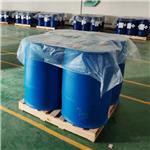1,3-Dimethyladamantane: Thermal Stability, EMS Study & High-Density Fuel Potential
1,3-Dimethyladamantane undergoes C-H insertion reaction with phenylchlorocarbene. It reacts with with molecular oxygen in the presence of N-hydroxyphthalimide combined with cobalt salts to yield 3,5-dimethyladamantan-1-ol and 5,7-dimethyladamantane-1,3-diol. 1,3-Dimethyladamantane was used in the synthesis of 1,3-dibromo-5,7-dimethyladamantane.

Thermal Stability and Decomposition Kinetics of 1,3-Dimethyladamantane
High energy-density hydrocarbon fuels have been attracting wide attention due to their high densities and volumetric heating values. The higher the volumetric heating value of a fuel is, the greater energy per unit volume can be provided, which is beneficial for improving the performance of the aircraft with restricted volume. High energy-density hydrocarbon fuels can be broadly classified as kerosene with large specific gravity, polycyclic or cage-like hydrocarbons with high density. A high density hydrocarbon fuel usually refers to that with a density higher than 0.8 g·cm–3, either a pure compound or a blended hydrocarbon fuel. Adamantane has high melt point (542 K), poor combustion performance and low solubility in the fuel. 1,3-Dimethyladamantane (1,3-DMA), as an alkyl derivative of adamantane, has tetrahedral cage-like structure. The density of 1,3-DMA is 0.9016 g·cm–3 (293 K), and its low-temperature property is adequate for many applications. The freeze point is 243 K, and the viscometric property is satisfactory (3.779 mPa·s, 293 K). Hence, 1,3-DMA has been expected to be used as one attractive component of high density fuels or fuel additives. Investigation on the thermal stability of 1,3-Dimethyladamantane should be a fundamental work to develop hydrocarbon fuels with high energy-density.[1]
The thermal stability of 1,3-DMA under different temperature–volume–pressure conditions has been investigated. The thermal decomposition kinetics of 1,3-Dimethyladamantane in the batch reactor are calculated quantitatively at temperatures from 693 to 743 K with the rate constants ranging from 4.00 × 10–7 s–1 at 693 K to 35.19 × 10–7 s–1 at 743 K, along with the Arrhenius parameters of A = 2.39 × 107 s–1 and activation energy Ea = 183 kJ·mol–1. The thermal decomposition of 1,3-DMA in the flowing reactor at temperatures from 873 to 973 K and pressures from 0.1 to 5.0 MPa is further performed. The conversion of thermal decomposition of 1,3-Dimethyladamantane at atmospheric pressure has relatively low values and increases obviously with increasing pressure because of different residence times (0.043–2.833 s). The calculated activation energy (Ea = 180 kJ·mol–1) for thermal decomposition of 1,3-DMA in the flowing reactor is consistent with the value (Ea = 183 kJ·mol–1) in the batch reactor. The relatively small rate constants for thermal decomposition of 1,3-DMA in the batch reactor indicate that its thermal stability is satisfactory at the given temperatures. The Arrhenius analysis for thermal decomposition of 1,3-DMA in the flowing reactor is also compared with that of JP-10 in the flowing reactor, and these two compounds exhibit similar trends of decomposition kinetics. The residence time is the main factor for the changes of the decomposition depth at high temperatures. The experimental results are hoped to provide reference information for the property optimization of new hydrocarbon fuels. Of course, if 1,3-Dimethyladamantane could be considered as a candidate, further engine testing under a broad range of conditions should be carried out.
Electron momentum spectroscopy study of 1,3-dimethyladamantane
Diamondoids are hydrogen-terminated nanocarbons composed of diamond cages, with the smallest one being adamantane. These molecules have attracted considerable attention due to their unique physical properties, high stability, and perfect size and shape selectivity. Electron momentum spectroscopy (EMS) is a technique that enables for the measurement of electron momentum density distributions of molecular orbitals through electron Compton scattering. In this study, we have performed EMS experiments on 1,3-dimethyladamantane. Although functionalized diamondoids have been identified as promising candidates for the tailoring of fluorescent nanomaterials, fluorescence has been shown to be quenched in many of them. It is therefore important to gain an understanding of methyl substitution effects on the HOMO in order to comprehend the role of methylation on the control of optical properties. To this end, the valence orbital momentum distributions of 1,3-dimethyladamantane are obtained from the EMS experiments, and the results are then compared with those of adamantane.[2]
This paper investigates the effects of methyl substitution on the valence orbital momentum distributions of adamantane. Kinematically complete electron-impact ionization experiments on 1,3-dimethyladamantane are performed at an incident electron energy of 1.2 keV, and the resulting electron momentum profiles are compared with those of pristine adamantane. Moreover, the influences of molecular vibration and distorted-wave effects on the electron momentum profiles are examined. The highest occupied molecular orbital (HOMO) of adamantane, 7t2, is split into the 10b1, 18a1, and 12b2 orbitals in 1,3-dimethyladamantane. It is revealed that the momentum profile for the sum of the 10b1, 18a1, and 12b2 orbitals exhibits a markedly higher intensity at low momentum than that of the 7t2 parent orbital. This strongly suggests that the HOMO is spatially more extended when surface hydrogens are replaced with methyl groups, which causes an increase in the absorption cross section of the 3 s Rydberg excitation.
References
[1] Xiaomei Qin. (2014). Thermal Stability and Decomposition Kinetics of 1,3-Dimethyladamantane. Energy & Fuels, 28 10, 6210–6220.
[2] Noboru Watanabe, Masahiko T., Keishi Fujiwara. (2024). Electron momentum spectroscopy study of 1,3-dimethyladamantane: Methyl substitution effects on the outer valence orbitals. Chemical Physics, 586, Article 112412.
You may like
Lastest Price from 1,3-Dimethyladamantane manufacturers

US $0.00-0.00/kg2025-09-26
- CAS:
- 702-79-4
- Min. Order:
- 1kg
- Purity:
- 99%
- Supply Ability:
- 1

US $5.00-0.50/KG2025-05-30
- CAS:
- 702-79-4
- Min. Order:
- 1KG
- Purity:
- 99% hplc
- Supply Ability:
- 500TONS


